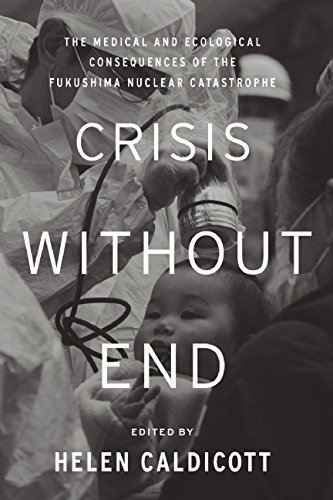

| CRISIS WITHOUT END The Medical and Ecological Consequences of the Fukushima Nuclear Catastrophe Helen Caldicott (ed.) New York: The New Press, October 2014 |
Rating: 4.5 Hign |
|||
| ISBN-13 978-1-59558-960-6 | ||||
| ISBN-10 1-59558-960-0 | 241pp. | HC/BWI | $26.95 | |
Australian pediatrician Dr. Helen Caldicott has devoted her life to a crusade against nuclear technology — which to her means nuclear weapons and electrical power generated by means of nuclear fission. This book is based on a 2013 symposium, which she organized. It is a compilation of reports on the Fukushima disaster, on the major accidents at other nuclear power plants, and on the past and projected impacts of these events on health. It begins with an Introduction by Dr. Caldicott which gives an accurate and succinct account of the Fukushima problems. But then, there is this:
Fukushima is now described as the greatest industrial accident in history. – Page 2 |
Very little research is needed to find that Bhopal,1 a non-nuclear industrial accident, deserves this description far more, and receives it.
Dr. Caldicott goes on to claim that "The radioactive fallout, which has covered vast swaths of Japan, will remain toxic for hundreds of thousands of years." This is true only in the academic sense. These radioisotopes will have decayed to levels indistinguishable from background in far less time. The worst will do so in decades. A simple rule of thumb applies: The hotter the isotope, the faster it fades.
On pages 3 and 4, she claims that Fukushima will have medical consequences identical to Chernobyl, which — citing a document2 published by the New York Academy of Sciences in 2009 — she asserts has already caused the deaths of more than one million people. One of the authors of this document is Academician Yablokov, who you will note makes accusations here of a massive coverup.
Being somewhat familiar with Dr. Caldicott's earlier work, and based on the errors in her Introduction, I was prepared to pan this entire volume. Fortunately, I read it first and avoided that mistake. With one notable exception, its chapters — based on presentations at a symposium that took place in New York City in March 2013 — contain much valuable information. I mark it down one notch because of that notable exception (which I discuss further at my "About that Symposium" link.) But the book is definitely worth reading. And for those who aren't following the radiation health journals or going to the original scientific papers, I judge it a keeper.

 To contact Chris Winter, send email to this address.
To contact Chris Winter, send email to this address.